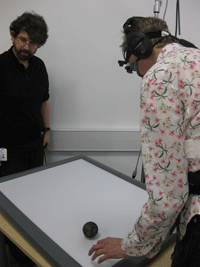Links
This page has links to research groups, individual researchers and projects that are related to the e-sense project. Some share some of our research goals, all of them are inspirational.
Research Labs
The High-Low Tech group at MIT integrates high and low technological materials, processes, and cultures. Their primary aim is to engage diverse audiences in designing and building their own technologies by situating computation in new cultural and material contexts, and by developing tools that democratize engineering.
Meta-Perception Research Group in the Ishikawa Komuro Laboratory, University of Tokyo. Their goal is to "research methods for capturing and manipulating information that is normally inaccessible to humans and machines". Click here for movies of this research, including the Haptic Radar project.
Researchers
Alvaro Cassinelli works in the Ishikawa Komuro Laboratory, University of Tokyo and researches the art and science of human-computer interfaces. He is co-creator with Carson Reynolds of the Haptic Radar.
Tom Froese's research into life and cognition is strongly inspired by the autopoietic tradition developed by Maturana, Varela and colleagues. He is very interested in the constructivist epistemology entailed by this perspective, as well as its relationship to first-person approaches to the study of consciousness, in particular as it is proposed by enactive cognitive science. He is the co-creator of the Enactive Torch.
Susanna Hertrich is an interaction designer who focuses on systems that communicate the social implications of emerging technologies. For example, the potential of extrasensory devices to act as prostheses for missing human instincts.
Carson Reynolds works in the Ishikawa Komuro Laboratory, University of Tokyo where he designs devices that alter perception and investigates their philosophical ramifications. One of his creations (with Alvaro Cassinelli) is the Haptic Radar
Adam Spiers is doing a PhD in humanoid robotic motion at Bristol University and is co-creator of the Enactive Torch.
Projects
C02 Corset, Kristin O'Friel, ITP. A corset that tightens as C02 levels increase.
Enactive Torch, Tom Froese, University of Sussex and Adam Spiers, Bristol University. This device provides the user's hand with one continuous channel of vibro-tactile feedback, where the strength of stimulation depends on the distance to the object which is currently pointed at (measured using ultrasound).
Fear Tuners explores the potential use of wearable devices as prostheses for sensing global and abstract dangers.
FeelSpace, Institute of Cognitive Science, University of Osnabrück. This project investigated the effects on humans of receiving long term vibrotactile stimulation that indicated magnetic north.
Haptic Radar, Meta-Perception Research Group, University of Tokyo. Two head-mounted IR sensors drive two vibration motors, sending stronger signals if objects are closer.

